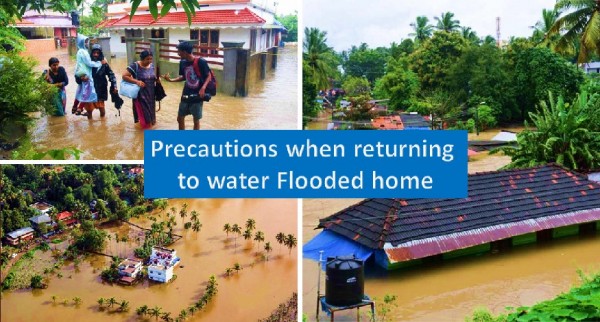
Precautions when returning to water Flooded home
Thousands of people are suffering for heavy rains and floods in Southern states of India – Kerala and Karnataka. Villages, towns and cities are evacuated and rescue operation is continuing in the midst of heavy rain. Once the rain stops, flood subsides. When returning to your home after a hurricane or flood, be aware that flood water may contain sewage. Protect yourself and your family by following these steps.
Precautions When Returning to Your Home
Electrical power and natural gas or propane tanks should be shut off to avoid fire, electrocution, or explosions.
Try to return to your home during the daytime so that you do not have to use any lights. Use battery-powered flashlights and lanterns, rather than candles, gas lanterns, or torches.
If you smell gas or suspect a leak, turn off the main gas valve, open all windows, and leave the house immediately.
Notify the gas company or the police or fire departments or State Fire Marshal’s office, and do not turn on the lights or do anything that could cause a spark. Do not return to the house until you are told it is safe to do so.
Inside the Home
- Keep children and pets out of the affected area until cleanup has been completed.
- Wear personal protective equipment, including rubber boots, rubber gloves, and goggles during cleanup of affected area.
- While cleaning up areas with mold damage, wear a NIOSH-approved N-95 respirator, or one that provides even more protection.
- Remove and discard items that cannot be washed and disinfected (such as, mattresses, carpeting, carpet padding, rugs, upholstered furniture, cosmetics, stuffed animals, baby toys, pillows, foam-rubber items, books, wall coverings, and most paper products).
- Remove and discard materials that has been contaminated with sewage or flood waters.
- This should include material that are located a foot higher than the high water line.
- Thoroughly clean all hard surfaces (such as flooring, concrete, molding, wood and metal furniture, countertops, appliances, sinks, and other plumbing fixtures) with hot water and laundry or dish detergent.
- Help the drying process by using fans, air conditioning units, and dehumidifiers.
- After completing the cleanup, wash your hands with soap and clean water.
- Wash all clothes worn during the cleanup in hot water and detergent. These clothes should be washed separately from uncontaminated clothes and linens.
- Wash clothes contaminated with flood or sewage water in hot water and detergent. It is recommended that a laundromat be used for washing large quantities of clothes and linens until your onsite waste-water system has been professionally inspected and serviced.
- Seek immediate medical attention if you become injured or ill.
- Care should be taken as wild animals might be taking shelter inside the house (like snakes and other reptiles)
Outside the Home
- Keep children and pets out of the affected area until cleanup has been completed.
- Wear rubber boots, rubber gloves, and goggles during cleanup of affected area.
- Have your onsite waste-water system professionally inspected and serviced if you suspect damage.
- Wash all clothes worn during the cleanup in hot water and detergent. These clothes should be washed separately from uncontaminated clothes and linens.
- After completing the cleanup, wash your hands with soap and clean water. Use water that has been boiled for 1 minute (allow the water to cool before washing your hands); or you may use water that has been disinfected for personal hygiene use:
- When using 5-6% unscented liquid household chlorine bleach – add a little less than 1/8 teaspoon (8 drops or about 0.5 milliliters) per 1 gallon of clear water. Stir well, and let it stand for 30 minutes before using. If the water is cloudy, add a little less than ¼ teaspoon (16 drops or about 1 milliliter) per 1 gallon of water.
- When using 8.25% unscented liquid household chlorine bleach – add a little less than 1/8 teaspoon (6 drops or about 0.5 milliliters) per 1 gallon of clear water. Stir well, and let it stand for 30 minutes before using. If the water is cloudy, add 12 drops (or about 1 milliliter) per 1 gallon of water.
This information is obtained from www.cdc.gov. For more information please visit: https://www.cdc.gov/disasters/floods/cleanupwater.html
Author: HealthyLife | Posted on: August 20, 2018
« Common causes and remedies for Urinary Tract Infection Skin Care Tips For Diabetic Patients »






















Write a comment